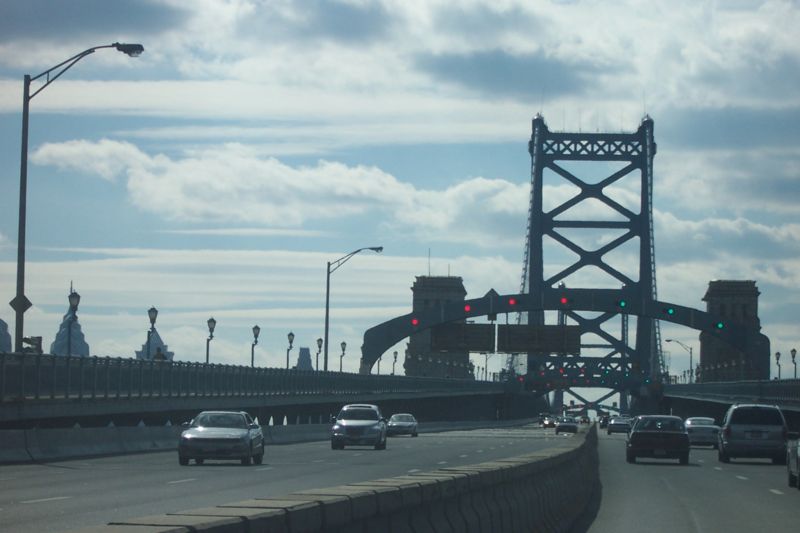| |||||||
Europe
North AmericaSouth AmericaAsiaAustralia and OceaniaAfrica |
Смотрите также: Benjamin Franklin Bridge The Benjamin Franklin Bridge (also known as the Ben Franklin Bridge), originally named the Delaware River Bridge, is a suspension bridge across the Delaware River connecting Philadelphia, Pennsylvania and Camden, New Jersey. Named for American statesman Benjamin Franklin, the bridge is owned and operated by the Delaware River Port Authority. Benjamin Franklin Bridge Official name Benjamin Franklin Bridge Carries 7 lanes of I-676 and US 30, 2 PATCO rail lines, and 2 sidewalks Crosses Delaware River Locale Philadelphia (Center City), Pennsylvania to Camden, New Jersey Design Steel suspension bridge Longest span 533.4 meters (1,750 feet) Total length 2,917.86 meters (9,573 feet) Width 39.01 meters (128 feet) Vertical clearance 5.12 meters (16.8 feet) Clearance below 41.19 meters (135 feet) Opening date July 1, 1926
History and use The chief engineer was Polish-born Ralph Modjeski, its design engineer was Leon Moisseiff, and the supervising architect was Paul Philippe Cret. At its completion on July 1, 1926, its 533-metre span made it the world's longest suspension bridge span, a distinction it would hold until the opening of the Ambassador Bridge in 1929. The bridge currently carries highways I-676 and US 30, the latter since its opening or very soon thereafter. Before the 1953 New Jersey State Highway renumbering, Route 25, Route 43 and Route 45 ended in the middle of the bridge. The bridge also carries the Port Authority Transit Corporation's Lindenwold High-Speed Line (PATCO Speedline) via connecting tunnels on both sides of the bridge.
Pedestrian walkways run along both sides of the bridge, elevated over and separated from the vehicular lanes; of these, only one is open at a time. Walkway hours are 6:00 a.m. to 6:00 p.m. (7:00 p.m. during daylight saving time). The DRPA temporarily closed the walkways to the public the day after the 7 July 2005 London bombings, citing security concerns. The DRPA also closes the walkway after snowfall, or if the weather forecast includes a chance of snowfall. The westbound approach to the bridge shows the zipper barrier and the overhead gantry lights. The seven vehicular lanes are divided by a concrete "zipper" barrier, which can be mechanically moved to configure the lanes for traffic volume or construction. Before the introduction of the zipper barrier, red and green signals mounted on overhead gantries indicated which lanes were open or closed to traffic in each direction. The gantries remain, but the addition of the zipper barrier allows all seven lanes of the bridge to carry traffic at all times; before it was installed, one lane of the bridge was kept closed at peak times to reduce the risk of head-on collisions. The bridges original design included six vehicular lanes and two streetcar tracks on the main deck, with provision for a rapid transit track in each direction outboard of the decks stiffening trusses, which rise above the deck rather than lie beneath it. The tracks were built to the nonstandard broad gauge of the Public Service Company of New Jerseys Camden streetcar system; the design called for the cars to cross the bridge from Camden to Philadelphia, enter an underground terminal beneath the bridge's west entrance plaza, and return to Camden via the opposite track. Streetcar stations were also built in the bridge's anchorages. None of the streetcar facilities were ever placed in service, as Public Service ran no cars across the bridge from its opening until the company abandoned its Camden streetcar system in 1932; after that, the tracks were removed and the space converted to vehicular lanes. The rapid transit tracks went into service in 1936 with the opening of the Bridge Line subway connecting Broadway and City Hall in Camden with 8th and Market streets in Philadelphia; the Bridge Line, extended to 16th and Locust in 1952, began carrying PATCO trains in 1969. Along with the Betsy Ross, Walt Whitman, and Tacony-Palmyra Bridges, the Benjamin Franklin is one of four primary bridges between Philadelphia and southern New Jersey. The Commodore Barry Bridge in Delaware County, Pennsylvania and the Burlington-Bristol Bridge in Bucks County, Pennsylvania connect suburban Philadelphia with southern New Jersey. Comments: 0 |
|
|||||








































